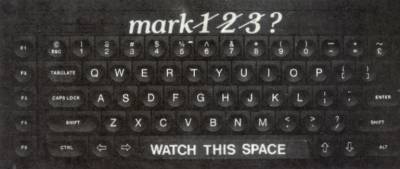| QL Revisited |

John Gilbert waxes warmer
THE QL COMPUTER reviewed in the July issue of Sinclair User was one of the first to go to customers. Since then Sinclair Research has produced several other versions, the latest of which contains the 48K ROM upgrade with which the company seems satisfied. It seems appropriate, therefore, to look at the machine in the light of those recent modifications.
The computer may not look different from the outside, although some keys on the keyboard still bounce and cause letter-repeat but the software has changed dramatically.
Most noticeable are the changes in QDOS, the multi-tasking, time-slicing operating system which takes care of the microdrives and the other peripheral devices.
The two drives are at least twice as fast on the new version than they were on the original. Their independence from other devices under the multi-task system is also more apparent. After 10 to 15 seconds of drive operation, when SAVEing a program, the keyboard goes back into operation and it is possible to type in the next command before the microdrive finishes its previous task.
You can also stack SuperBasic commands to devices such as microdrives. One command is executed after another but the job scheduling part of QDOS will execute the tasks as if they are all running together. It is impressive to watch and saves time on a slow machine.
The Sinclair decision to use the 68008 as the main processor has been debated and criticised by certain sections of the press. The reason is that many journalists are annoyed because Nigel Searle is calling the QL a 32-bit machine. They see it as an 8-bit micro with 32-bit internal structure. While that is correct it would have been confusing to put 32/8-bits on the specification. Sinclair may have chosen the bigger number but that is all part of the sales pitch and is not untrue.
The argument about the chip specification is a little pointless, as the 68008 can still handle 32 bits of information. It has to do it in smaller blocks and, as a result, the chip works slightly slower than the 68000 or its bigger brother, the 68032. There is no reason why, the QL should not handle software which has been written for those other two processors and that puts the machine into 2 new league of computers in terms of chip compatibility and programming.
The internal structure of the QL makes SuperBasic slower than it could be but the language is still one of the most innovative and powerful Basic interpreters on the market. The structured format, which has changed several times since the original specification was released, is compatible with BBC Basic and also includes a set of turtle graphics commands which are a great improvement on the original.
In the original Sinclair User review of the QL it was stated that the program editing facilities of the computer were appalling. The latest model provides better commands but the QL still has only a line editor. No full-screen editor is provided, which is a pity, as it would have been easier to operate.
The new editor traps lines which contain errors and send them back to the editing window for correction. You can either erase them completely, or scan the line and do the correction.
SuperBasic may be slow but the number-crunching abilities of the QL, in which many people in the business and scientific community will be interested, puts it in the middle of the serious professional market if nothing else does. It can out-calculate machines such as the Apple II and IIe and also the IBM PC and it can do it in almost three-quarters of the time.
That opens new fields of use in the engineering and scientific industries. The 68008 will also provide plenty of scope for students in those areas who need inexpensive computing power.
The so-called window facility provided by Sinclair on the QL cannot be ignored in the hope that it might go away. The computer does not provide real windowing which can be found on the bigger, and more expensive machines, such as the Apple Macintosh or Lisa.
True windowing requires extra hardware which costs money and which is not available on a low budget machines such as the QL. The Sinclair computer uses a software technique to create the windows which might better be described as display areas connected to channels through which information, such as listings, can be sent to the screen.
The QL windows, while being attractive and impressive to beginners, have little to do with multi-tasking, as Sinclair would first have had users and journalists believe. You cannot run several SuperBasic listings together on the machine, even if you put them in separate windows.
Although it is still easy to gloss over the QL marketing policy, it is difficult to find drastic faults with a product which costs £400 and offers professional computing power, albeit at the low end of the market.
The QL still has its fair share of bugs and they will have to be ironed out. It is, however, beginning to fulfil the potential which it had when first launched.
Sinclair should not be complacent. Software and hardware support must be produced quickly and in great quantities or other manufacturers, such as Acorn or Spectravideo, will jump on the 16- or 32-bit bandwagon. Sinclair Research has a narrow lead which could be eroded. If the company does not get it right this time it may not have the opportunity to try again.